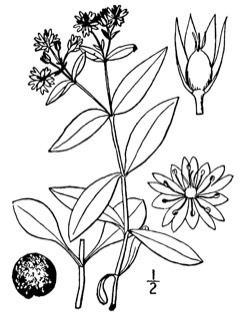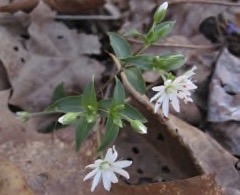 |
|
edibleplants.org |
 |
| Mason Brock (Masebrock) wikimedia.org |
Translate this page:
Summary
Physical Characteristics

 Stellaria pubera is a PERENNIAL growing to 0.2 m (0ft 8in) by 0.2 m (0ft 8in) at a fast rate.
Stellaria pubera is a PERENNIAL growing to 0.2 m (0ft 8in) by 0.2 m (0ft 8in) at a fast rate.
See above for USDA hardiness. It is hardy to UK zone 6. The flowers are pollinated by Bees, Insects.
It is noted for attracting wildlife.
Suitable for: medium (loamy) and heavy (clay) soils and prefers well-drained soil. Suitable pH: mildly acid and neutral soils. It can grow in full shade (deep woodland) or semi-shade (light woodland). It prefers moist soil.
UK Hardiness Map
US Hardiness Map
Synonyms
Alsine pubera (Michx.) Britton
Plant Habitats
Edible Uses
Leaves. Lettuce like greens - good [2-1]. Fresh greens - salad, potherb, dried and added to soups. Seeds sprouted and eaten [318-1]. Probably similar qualities to Stellaria media.
References More on Edible Uses
Medicinal Uses
Plants For A Future can not take any responsibility for any adverse effects from the use of plants. Always seek advice from a professional before using a plant medicinally.
Although no information could be found for this species it is likely to have similar properties to Stellaria media. Stellaria media (Chickweed) has a very long history of herbal use, being particularly beneficial in the external treatment of any kind of itching skin condition[238]. It has been known to soothe severe itchiness even where all other remedies have failed[254]. In excess doses chickweed can cause diarrhoea and vomiting[254]. It should not be used medicinally by pregnant women[254]. The whole plant is astringent, carminative, demulcent, diuretic, expectorant, laxative, refrigerant, vulnerary[4, 7, 9, 21, 54, 165, 222]. Taken internally it is useful in the treatment of chest complaints and in small quantities it also aids digestion[254]. It can be applied as a poultice and will relieve any kind of roseola and is effective wherever there are fragile superficial veins[7]. An infusion of the fresh or dried herb can be added to the bath water and its emollient property will help to reduce inflammation - in rheumatic joints for example - and encourage tissue repair[254]. Chickweed is best harvested between May and July, it can be used fresh or be dried and stored for later use[4, 238]. A decoction of the whole plant is taken internally as a post-partum depurative, emmenagogue, galactogogue and circulatory tonic[218]. It is also believed to relieve constipation and be beneficial in the treatment of kidney complaints[244]. The decoction is also used externally to treat rheumatic pains, wounds and ulcers[4, 218, 222]. The expressed juice of the plant has been used as an eyewash[244].
References More on Medicinal Uses
The Bookshop: Edible Plant Books
Our Latest books on Perennial Plants For Food Forests and Permaculture Gardens in paperback or digital formats.

Edible Tropical Plants
Food Forest Plants for Hotter Conditions: 250+ Plants For Tropical Food Forests & Permaculture Gardens.
More

Edible Temperate Plants
Plants for Your Food Forest: 500 Plants for Temperate Food Forests & Permaculture Gardens.
More

More Books
PFAF have eight books available in paperback and digital formats. Browse the shop for more information.
Shop Now
Other Uses
A good medium to high density grouncover [1-2]. Soap - Contains saponins [318-1]. Insectory: The flowers of Star Chickweed attract cuckoo bees (Nomada spp.), mason bees (Osmia spp.), Halictid bees (Augochlorella spp., Lasioglossum spp.), Andrenid bees (Andrena spp.), the Giant Bee Fly (Bombylius major), Syrphid flies, and other miscellaneous flies. Butterflies and skippers are rare visitors of the flowers. These insects are attracted primarily to the nectar of the flowers, although some of the bees collect pollen for their larvae and some of the flies feed on pollen as adults. Insects that feed on Stellaria spp., including possibly this chickweed, are the aphid Abstrusomyzus phloxae, the Pale Tortoise Beetle (Cassida flaveola), and caterpillars of a moth, Lobocleta ossularia (Drab Brown Wave) [318-1].
Domestic animal forage: Used to feed chickens [318-1].
Special Uses
References More on Other Uses
Cultivation details
A perennial herbaceous wildflower for Partial or Dappled Shade. Water Preferences: Mesic (environment or habitat containing a moderate amount of moisture). Soil pH preferences: Slightly acid (6.1 – 6.5). Flowers: White/Showy. Bloom Time: Mar to May. Resistances: Humidity tolerant.
References Carbon Farming Information and Carbon Sequestration Information
Temperature Converter
Type a value in the Celsius field to convert the value to Fahrenheit:
Fahrenheit:
The PFAF Bookshop
Plants For A Future have a number of books available in paperback and digital form. Book titles include Edible Plants, Edible Perennials, Edible Trees,Edible Shrubs, Woodland Gardening, and Temperate Food Forest Plants. Our new book is Food Forest Plants For Hotter Conditions (Tropical and Sub-Tropical).
Shop Now
Plant Propagation
Seed
Other Names
If available other names are mentioned here
Star Chickweed
Native Range
Coming Soon
Weed Potential
Right plant wrong place. We are currently updating this section.
Please note that a plant may be invasive in one area but may not in your area so it's worth checking.
None Known
Conservation Status
IUCN Red List of Threatened Plants Status : Not Listed.

Growth: S = slow M = medium F = fast. Soil: L = light (sandy) M = medium H = heavy (clay). pH: A = acid N = neutral B = basic (alkaline). Shade: F = full shade S = semi-shade N = no shade. Moisture: D = dry M = Moist We = wet Wa = water.
Now available:
Food Forest Plants for Mediterranean Conditions
350+ Perennial Plants For Mediterranean and Drier Food Forests and Permaculture Gardens.
[Paperback and eBook]
This is the third in Plants For A Future's series of plant guides for food forests tailored to
specific climate zones. Following volumes on temperate and tropical ecosystems, this book focuses
on species suited to Mediterranean conditions—regions with hot, dry summers and cool, wet winters,
often facing the added challenge of climate change.
Read More
Expert comment
Author
Michx.
Botanical References
Links / References
For a list of references used on this page please go here
Readers comment
| Add a comment |
|
If you have important information about this plant that may help other users please add a comment or link below. Only comments or links that are felt to be directly relevant to a plant will be included. If you think a comment/link or information contained on this page is inaccurate or misleading we would welcome your feedback at [email protected]. If you have questions about a plant please use the Forum on this website as we do not have the resources to answer questions ourselves.
* Please note: the comments by website users are not necessarily those held by PFAF and may give misleading or inaccurate information.
To leave a comment please Register or login here All comments need to be approved so will not appear immediately.
|
Subject : Stellaria pubera
|
|
|
|